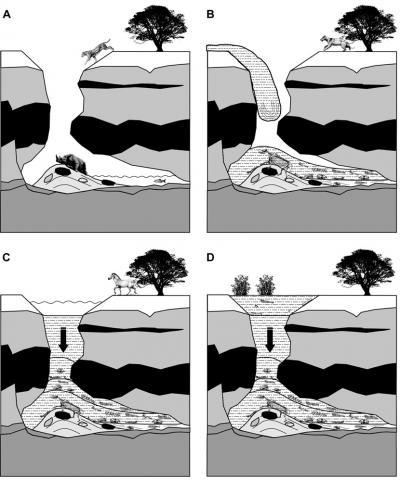Why did saber-toothed cats, hyenas, an extinct 'bear-dog', ancestors of the red panda and several other carnivores die under unusual circumstances in a Spanish cave near Madrid approximately 10 million years ago?
Different scenarios have been floated for why an unusually large concentration of healthy adult carnivores died in this cave during the Late Miocene, a location known now as Batallones-1 fossil site, Madrid Basin, Spain; accidental falls into the cave, maybe the animals died in other locations and were washed into the cave, everything but mass suicide.
Yet those scenarios would mean mean herbivores also got trapped. And not just healthy adults.
Researchers examined the geological conditions under which the cave was formed, the age of individuals in the cave and the time frame over which they likely entered this pit. They used tracking clues like the demography of the individuals recovered, the orientation of the remains and the scarcity of fractured bones or trampling marks.

This shows the partially articulated skeleton of the hyena Protictitherium crassum. Credit: Domingo MS, Alberdi MT, Azanza B, Silva PG, Morales J (2013) Origin of an Assemblage Massively Dominated by Carnivorans from the Miocene ofSpain. PLoS ONE 8(5): e63046. doi:10.1371/journal.pone.0063046
Their conclusion was that the animals most likely actively entered the cavity in search of food or water over a protracted period of time and were subsequently unable to make their way out, ultimately dying in the cave. They suggest that the scarcity of herbivore remains may indicate that the cavity was clearly visible and thus avoided by these animals. Fossil bones in this site exhibit a very good preservation state as a consequence of their deposition in the restricted and protective environment of the chamber.

Reconstruction of the processes that led to the accumulation of fossil bones in Batallones-1. A) Carnivores intentionally enter into the cave. B) Episodic floods filled the cavity and buried remains in different articulation stages; repeated carnivoran entrances through time. C) Final stages of the filling of the chamber: the location is not a carnivore trap anymore. D) Deposition of elements from the upper level assemblage of Batallones-1 in an uncertain taphonomic context (entrapment of herbivores?). Art by Mauricio Antón, Israel M. Sánchez and M. Soledad Domingo. Credit: Domingo MS, Alberdi MT, Azanza B, Silva PG, Morales J (2013) Origin of an Assemblage Massively Dominated by Carnivorans from the Miocene ofSpain. PLoS ONE 8(5): e63046. doi:10.1371/journal.pone.0063046
Citation: Domingo MS, Alberdi MT, Azanza B, Silva PG, Morales J (2013) Origin of an Assemblage Massively Dominated by Carnivorans from the Miocene of Spain. PLoS ONE 8(5): e63046. doi:10.1371/journal.pone.0063046





Comments